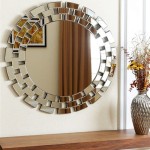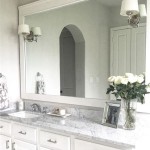Faux Painting Mirror Ideas
Mirrors, beyond their functional purpose, serve as versatile decorative elements that can enhance the aesthetic appeal of any living space. While the mirror itself reflects light and creates the illusion of spaciousness, the frame surrounding it provides an opportunity for creative expression through various techniques. Faux painting, a decorative technique that mimics the appearance of other materials such as wood, marble, or metal, offers numerous possibilities for transforming ordinary mirror frames into unique and eye-catching focal points. This article explores several faux painting techniques that can be applied to mirror frames, providing inspiration for enhancing home décor.
Understanding Faux Painting Techniques
Faux painting encompasses a broad range of decorative finishes designed to replicate the visual characteristics of natural materials or create abstract textural effects. The selection of a suitable faux painting technique for a mirror frame depends on the desired aesthetic, the existing décor of the room, and the skill level of the individual undertaking the project. Some popular faux painting techniques include:
Color Washing: This technique involves applying a translucent layer of paint over a base coat to create a soft, textured effect. The process typically uses two or more complementary colors to achieve depth and visual interest. Color washing is a relatively simple technique suitable for achieving a rustic or antique look.
Rag Rolling: This technique uses a rag to apply or remove paint from a surface, creating a textured pattern. The rag can be rolled, crumpled, or dabbed onto the surface to achieve different effects. Rag rolling is versatile and can be used to create both subtle and dramatic textures.
Sponging: Similar to rag rolling, sponging uses a natural or synthetic sponge to apply paint to a surface. The sponge creates a more uniform texture compared to rag rolling, making it suitable for replicating materials like stone or stucco.
Strie: This technique involves dragging a brush or comb through wet paint to create fine, linear patterns. Strie is often used to mimic the look of linen or other textured fabrics.
Venetian Plaster: This technique uses a mixture of plaster and marble dust to create a smooth, polished finish that resembles marble. Venetian plaster requires more skill and experience compared to other faux painting techniques, but the results can be stunning.
Wood Graining: This technique uses various tools and techniques to replicate the look of wood grain. Wood graining can be used to transform plain mirror frames into realistic-looking wood finishes.
Applying Faux Painting to Mirror Frames: Key Considerations
Before beginning a faux painting project on a mirror frame, several factors must be considered to ensure a successful outcome. These factors include surface preparation, material selection, and application techniques.
Surface Preparation: Proper surface preparation is crucial for the adhesion and durability of the faux finish. The mirror frame should be thoroughly cleaned to remove any dirt, dust, or grease. If the frame has an existing finish, it may need to be sanded or primed to provide a suitable surface for the new paint. Frames made of smooth, non-porous materials such as metal or plastic may require a bonding primer to ensure proper adhesion.
Material Selection: The selection of appropriate materials, including paints, glazes, and tools, is essential for achieving the desired faux finish. Acrylic paints are generally recommended for faux painting due to their versatility, durability, and ease of use. Water-based glazes can be used to create translucent layers and enhance the depth of the finish. The choice of brushes, sponges, rags, and other tools will depend on the specific faux painting technique being used.
Application Techniques: Mastering the correct application techniques is essential for achieving a professional-looking faux finish. It is advisable to practice the chosen technique on a sample board before applying it to the mirror frame. This allows for experimentation with different colors, glazes, and tools, as well as refining the application process. Attention to detail, patience, and a steady hand are crucial for achieving the desired results.
Sealing and Protection: Once the faux finish has been applied and allowed to dry completely, it is recommended to seal it with a clear topcoat to protect it from damage and enhance its durability. A water-based polyurethane varnish is a suitable option for sealing faux finishes on mirror frames. The topcoat should be applied in thin, even layers, allowing each layer to dry completely before applying the next.
Specific Faux Painting Ideas for Mirror Frames
The possibilities for faux painting mirror frames are virtually limitless. Here are some specific ideas to inspire creativity:
Distressed Antique Finish: This technique creates a weathered, aged look by layering different colors and sanding them back to reveal the underlying layers. Start with a dark base coat, such as black or brown, and then apply layers of lighter colors, such as cream, beige, or gray. Once the paint is dry, use sandpaper to distress the edges and corners of the frame, exposing the darker base coat. This technique is ideal for creating a rustic or vintage-inspired aesthetic.
Metallic Finish: This technique uses metallic paints or glazes to create a shimmering, opulent look. Gold, silver, copper, and bronze are popular choices for metallic finishes. Apply a base coat of a complementary color, such as black or dark brown, and then apply the metallic paint or glaze in thin, even layers. Use a soft cloth or brush to buff the surface, enhancing the metallic sheen. This technique is suitable for creating a glamorous or contemporary aesthetic.
Marble Finish: This technique involves replicating the look of marble using paints, glazes, and specialized tools. Start with a light base coat, such as white or cream, and then use a feather or artist's brush to create veins in various colors, such as gray, brown, or green. Blend the veins with a soft cloth or brush to create a realistic marble effect. This technique requires more skill and practice, but the results can be stunning.
Wood Grain Finish: This technique involves replicating the look of wood grain using specialized tools, such as a graining comb or rocker. Apply a base coat of a wood-tone color, such as oak, walnut, or mahogany, and then use the graining tool to create the wood grain pattern. Apply a glaze over the graining to enhance the depth and dimension of the finish. This technique is suitable for creating a traditional or rustic aesthetic.
Textured Finish with Stencils: This technique uses stencils and texture mediums to create raised patterns on the mirror frame. Apply a base coat of paint and then use a stencil and a palette knife to apply the texture medium in the desired pattern. Remove the stencil and allow the texture medium to dry completely. Paint over the textured surface with a complementary color or use a metallic glaze to highlight the pattern. This technique is ideal for adding visual interest and dimension to the mirror frame.
Ombre Effect: This technique involves blending two or more colors together to create a gradual transition from light to dark (or vice-versa). Choose colors that complement the existing décor of the room and apply them to the mirror frame, blending them seamlessly together. This technique creates a contemporary and stylish look.
Geometric Patterns: This technique incorporates geometric shapes, such as stripes, chevrons, or triangles, into the design of the mirror frame. Use painter's tape to create the desired pattern and then apply paint in the chosen colors. Remove the tape and allow the paint to dry completely. This technique offers a modern and visually appealing look.
Faux painting offers a cost-effective and creative way to personalize mirror frames and enhance the overall aesthetic of a room. By carefully considering the desired look, selecting the appropriate techniques and materials, and practicing proper application methods, individuals can transform ordinary mirror frames into unique and eye-catching works of art.

30 Diy Mirror Frames Scratch And Stitch

Painting A Mirror Frame Easy Yet Stunning Ideas Girl In The Garage

15 Thrifty Mirror Makeovers Confessions Of A Serial Do It Yourselfer

30 Diy Mirror Frames Easy Frame

Painting A Mirror Frame Easy Yet Stunning Ideas Girl In The Garage

12 Techniques To Painting Antique Mirrors Hallstrom Home

Window Pane Mirror With Faux Antique Mercury Glass Diy

Painting A Mirror Frame Easy Yet Stunning Ideas Girl In The Garage

20 Diy Mirror Frame Ideas To Make Your Own Decorative

Turn An Old Mirror Into A Gorgeous Piece Of Art Recreated Designs








